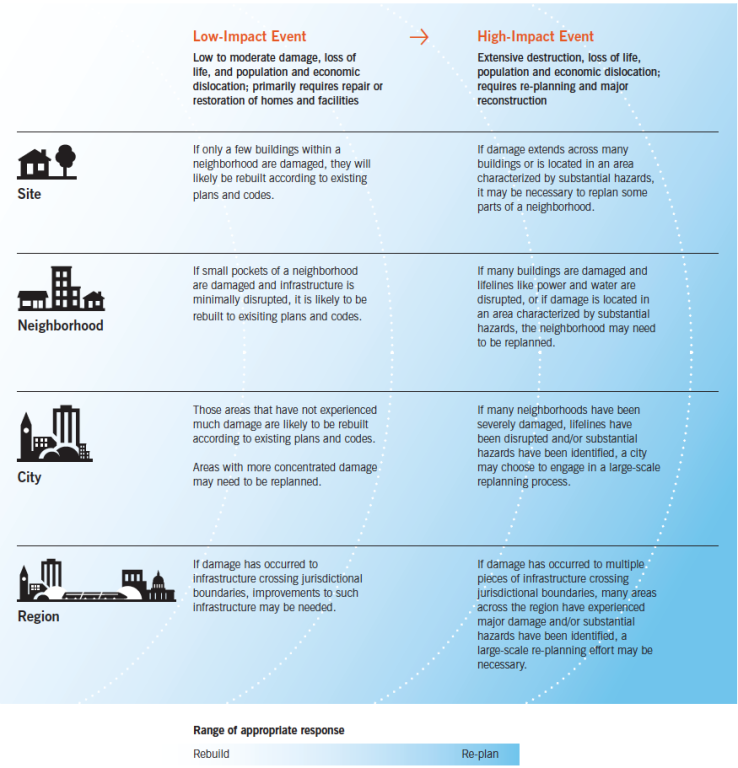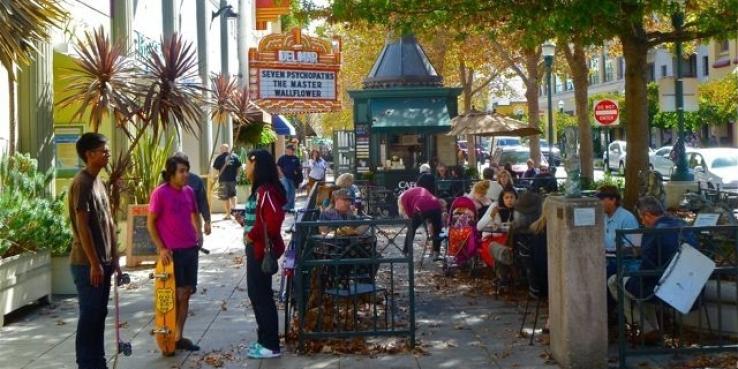California is burning. At the time of this writing, 220,000 acres of land have burned or are still burning in Sonoma and Napa counties — the deadliest wildfire disaster in California history. 5,700 homes lost. More than 40 dead. Dozens still missing. All last week you could smell the burning for miles. Depending on where you are now and which way the wind is blowing, you can still smell it. Outside my home in Oakland, the air moves in and out of being strange and hazy. When the air is bad, I check the Air Quality Index hourly wondering if I should pull my toddler out of pre-school and head for somewhere safe, although where that magical “safe” place is these days is hard to know.
The scale of the devastation unfolding in the North Bay is a painful reminder of the earthquake disasters SPUR has studied over the years, all the lessons learned and unlearned. As first responders valiantly work to contain the damage and save lives, government officials will soon need to shift their attention to the daunting task of rebuilding the northern part of our region. What should they do? And what can we do to help?
The First Plan
After a disaster, people start talking about recovery plans. If the people affected feel like their voices aren’t being taken into account, the results can make recovery efforts even more painful and difficult. The truth is that most people affected by disaster already have a recovery plan in mind: rebuilding exactly what they had before the disaster. Recovery expert Laurie Johnson calls this the “first plan.” The first plan is very powerful, especially in uncertain and emotional times, when people have lost everything. But sometimes the first plan might not be the best plan, especially when there are hazards to take into account and infrastructure to be rebuilt. Local governments will need to do a lot of work to figure out how to make new development more fire resilient, as well as how to plan for development that could be impacted by the Rodgers Creek Fault (which scientists recently learned is connected to the Hayward Fault). They will also need to think about how to rebuild in a way that creates more housing opportunities for all the people who want to live here, especially in parts of the region that have historically been more economically diverse, like Santa Rosa. All of this will, to some extent, require rebuilding in ways that are different from the first plan. Working toward the best plan takes a lot of patience, humility, thoughtfulness and political courage.
“Gearing Up and Sorting Out” Versus “Ready, Fire, Aim”
As part of my work developing SPUR’s thinking on disaster resilience, I was lucky enough to spend some time learning from Charles Eadie, who managed the development of Santa Cruz’s downtown recovery plan after the Loma Prieta earthquake. He talked to me about the period of time after a disaster when everything is uncertain, even the question of who is in charge of doing what. Rather than “ready, aim, fire,” the process can feel more like “ready, fire, aim”: In response to enormous public pressure to do something, decision makers try to act quickly, but the speed of action creates missteps and backtracking. In the end, acting quickly may cause recovery to take longer and be less successful.
Instead, Charles recommended a process he calls “gearing up and sorting out.” This involves thinking through the answers to a series of questions, including the following: What happened and how bad is it? What additional information do we need to understand the situation? What does recovery look like? What is the desired end state? Given the damage and the recovery goals, which parts of the recovery can take place with a limited degree of difficulty? What looks difficult or infeasible for any reason? What additional information do we need to understand feasibility?
As public officials think through these questions, there may be opportunities to rebuild communities to make them better than they were before. Officials will need to decide which of these opportunities, if any, are worth pursuing. They will also need to determine who can do what, as well as what the process for deciding looks like. Gearing up and sorting out is challenging and iterative, but if these key questions can be answered, they will help keep everything on track.
Rebuild or Re-Plan?
In 2013, SPUR issued a report called On Solid Ground: How Good Land Use Planning Can Prepare the Bay Area for a Strong Land Use Recovery. The report talks about the challenges of the first plan and about the process of gearing up and sorting out. It also discusses the complex challenge of determining whether to re-plan or rebuild. As mentioned above, one of the biggest challenges officials will face is whether to enable people to rebuild what was there before (the first plan) or to instead re-plan, taking hazards and potential improvements into account. It is much too early to know what will happen in the North Bay. But at minimum, thinking through future fire risk, as well as earthquake hazards and other climate change challenges, should be part of any future plan. Thinking through ways to encourage more housing affordability should also be part of the picture.
 Rebuilding takes place on many scales: at the individual site and at the neighborhood, city and regional levels. If damage is modest, individual buildings are likely to be rebuilt to existing plans and codes. If damage is more severe and covers most of a city or region, re-planning may be necessary. From On Solid Ground, page 14. Source: Adapted from a table developed by Ken Topping.
Rebuilding takes place on many scales: at the individual site and at the neighborhood, city and regional levels. If damage is modest, individual buildings are likely to be rebuilt to existing plans and codes. If damage is more severe and covers most of a city or region, re-planning may be necessary. From On Solid Ground, page 14. Source: Adapted from a table developed by Ken Topping.
There are many complex issues involved with recovery. The prospect is daunting, especially when the fires are still burning and there are so many people terrified, so many people missing and grieving. The good news is that we are not alone: Other cities and regions have traveled this road before us. We can learn from their successes, and from their mistakes.
For Now, the Focus Must Be on Response
As the fires continue to burn, as ash rains down upon our region, our thoughts are will those who have lost homes and loved ones. We hope that the winds turn in our favor, that the fires will be contained quickly, and that sooner, rather than later, we can rebuild our beautiful region, stronger and even more resilient than before.
If you would like to help those affected by the fires, here are some options:
Napa Valley Community Foundation
Community Foundation of Mendocino County
North Bay Fire Relief Fund — Redwood Credit Union, Press Democrat and State Senator Mike Maguire
Tubbs Fire Victims Fund — City of Santa Rosa
Tipping Point Emergency Relief Fund
More resources from the San Francisco Chronicle
More resources from the Marin Community Foundation
